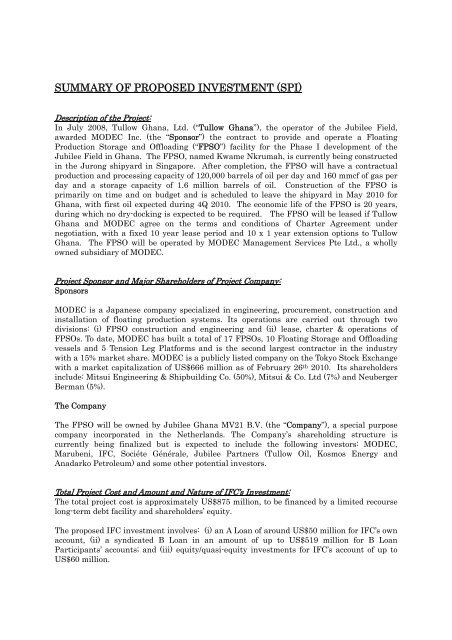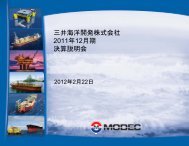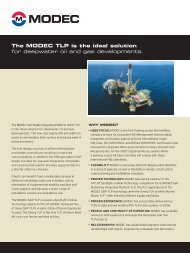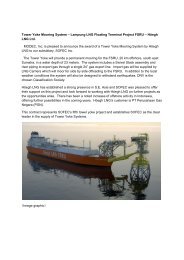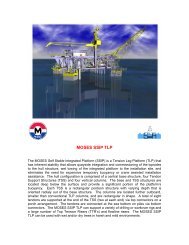(IFC) in relation to Jubilee Ghana FPSO - modec
(IFC) in relation to Jubilee Ghana FPSO - modec
(IFC) in relation to Jubilee Ghana FPSO - modec
You also want an ePaper? Increase the reach of your titles
YUMPU automatically turns print PDFs into web optimized ePapers that Google loves.
Page 3People, there are no <strong>in</strong>digenous people liv<strong>in</strong>g near the Project. PS 8: Cultural Heritage doesnot apply because of the already-noted limited shore-based impact.E&S Categorization Rationale:Consistent with the categorization assigned <strong>to</strong> both Tullow and Kosmos projects for thePhase 1 Development of the <strong>Jubilee</strong> Field, the <strong>FPSO</strong> project, which is a component of thesame field development, is a Category B project accord<strong>in</strong>g <strong>to</strong> <strong>IFC</strong>’s Environmental and SocialReview Procedures, because a limited number of specific environmental and social impactsmay result that can be avoided or mitigated by adher<strong>in</strong>g <strong>to</strong> generally recognizedperformance standards, guidel<strong>in</strong>es, or design criteria. The key issues identified dur<strong>in</strong>gappraisal of the project, and described <strong>in</strong> detail <strong>in</strong> this Environmental and Social ReviewSummary, were:- Implementation of the sponsor’s <strong>in</strong>tegrated HSE management system at project leveldur<strong>in</strong>g construction and operation of the <strong>FPSO</strong>, and <strong>in</strong>tegration with the Unit Opera<strong>to</strong>rmanagement system;- Implementation of the <strong>FPSO</strong> hull <strong>in</strong>tegrity and safety measures, <strong>in</strong>clud<strong>in</strong>g operations,ma<strong>in</strong>tenance and <strong>in</strong>spection;- Management of production water, bilge water, deck dra<strong>in</strong>age water, ballast water, andhydrostatic test<strong>in</strong>g water;- Implementation of the emergency response plan, <strong>in</strong>clud<strong>in</strong>g oil spill preparedness andresponse measures;- Compliance with <strong>IFC</strong> and the International Convention for the Prevention of Pollutionfrom Ships (“MARPOL”) requirements for the management of air emissions (particularlyrelated <strong>to</strong> m<strong>in</strong>imization of flar<strong>in</strong>g and vent<strong>in</strong>g, and greenhouse gas emissions), producedwater, other wastewater and contam<strong>in</strong>ated waters, and hazardous materials and wastes;- Occupational health and safety management dur<strong>in</strong>g operation of the <strong>FPSO</strong>, <strong>in</strong>clud<strong>in</strong>g jobhazard analyses, fire and explosion prevention and control, personnel transfer and vessels,workplace air quality, and housekeep<strong>in</strong>g; and- Labor and work<strong>in</strong>g conditions for MODEC’s <strong>Ghana</strong> operations.The <strong>FPSO</strong> will be located at the northern edge of the <strong>Jubilee</strong> field <strong>in</strong> approximately 1,100mof water, approximately 60 km from the nearest po<strong>in</strong>t on the coast with <strong>Ghana</strong>. The locationof the <strong>FPSO</strong> will mean that impacts from production waste will be limited, and any healthand safety issues can be readily handled us<strong>in</strong>g well-known procedures and eng<strong>in</strong>eer<strong>in</strong>gtechnology. S<strong>in</strong>ce mitigation measures for the identified impacts can be readily def<strong>in</strong>ed,adverse impacts are not expected <strong>to</strong> be diverse or irreversible, and they will be limited <strong>to</strong> theproject area.Description of key Enviornmental and Social Issues and Mitigation:The Un<strong>in</strong>corporated Jo<strong>in</strong>t Venture (“UJV”) for the Phase 1 Development of the <strong>Jubilee</strong> Fieldhas presented plans <strong>to</strong> address the identified impacts for the Phase 1 Development, asdiscussed <strong>in</strong> the Tullow and Kosmos ESRS’s. These plans, <strong>in</strong>clud<strong>in</strong>g Contrac<strong>to</strong>r HSEPerformance Requirements and the <strong>FPSO</strong> technical specifications, and the MODECcorporate and project HSE management systems will ensure that the proposed project,which is a component of the Phase 1 Development project, will, upon the implementation ofthe specific agreed measures, comply with the environmental and social requirements: 1) thehost country laws and regulations, 2) the <strong>in</strong>ternational treaties and <strong>in</strong>dustry standards, 3)
Page 4the <strong>IFC</strong> environment and social Performance Standards and 4) the applicable and relevant<strong>IFC</strong> environmental, health and safety guidel<strong>in</strong>es. The <strong>in</strong>formation about how the potentialimpacts will be addressed by the Project is summarized <strong>in</strong> the paragraphs that follow. Thesponsor has developed and agreed <strong>to</strong> implement the attached Environmental and SocialAction Plan (“ESAP”) <strong>to</strong> address the gaps <strong>in</strong> its current environmental and social assessmentand management system, applicable <strong>to</strong> the proposed project, and <strong>to</strong> meet the requirementsof the applicable <strong>IFC</strong>’s Performance Standards and identified aspects of the relevant andapplicable EHS Guidel<strong>in</strong>es.PS 1: Social and Environmental Assessment and Management SystemsAssessment. Under the <strong>Ghana</strong> Environmental Assessment Regulations LI 1652 1999,Tullow and partners were required <strong>to</strong> submit an Environmental Impact Statement (“EIS”)for the <strong>Jubilee</strong> field <strong>to</strong> the <strong>Ghana</strong> EPA. The f<strong>in</strong>al EIS was submitted <strong>in</strong> November 2009.<strong>FPSO</strong> <strong>in</strong>stallation, commission<strong>in</strong>g and operation (i.e., production, hydrocarbon process<strong>in</strong>g,crude oil offload<strong>in</strong>g, and support and ma<strong>in</strong>tenance activities) are activities <strong>in</strong>cluded <strong>in</strong> thePhase 1 Development project. On December 31, 2009 the EPA issued an environmentalpermit allow<strong>in</strong>g the <strong>in</strong>stallation of equipment and commission<strong>in</strong>g of the <strong>Jubilee</strong> Field Phase1 Development project. The EPA will issue a separate permit for the operations phase of thePhase 1 Development, subject <strong>to</strong> the submission of additional <strong>in</strong>formation prescribed underthe permit schedule. It is a responsibility of Tullow <strong>Ghana</strong>, the Unit Opera<strong>to</strong>r, <strong>to</strong> meet theEPA’s requirements <strong>to</strong> obta<strong>in</strong> the permit for the operations phase. MODEC and itssubsidiary MODEC <strong>Ghana</strong> will follow the relevant Contrac<strong>to</strong>r HSE PerformanceRequirements def<strong>in</strong>ed by the Phase 1 Development project, and therefore will meet therelevant requirements of the <strong>Ghana</strong> EPA permits.Management Program. The sponsor has a Corporate HSE Management System (“HSE MS”)that is accredited <strong>to</strong> ISO 14001 and OHSAS 18001. The management system is fullydeveloped and is currently be<strong>in</strong>g implemented throughout MODEC facilities and operationsworldwide. The HSE MS follows a structured hierarchical approach <strong>to</strong> manag<strong>in</strong>g HSE risks,accord<strong>in</strong>g <strong>to</strong> the follow<strong>in</strong>g levels: Tier 1: HSE Policy; Tier 2: HSE Standards; Tier 3A:Corporate Management System, compris<strong>in</strong>g procedures and processes outl<strong>in</strong><strong>in</strong>g activities formanag<strong>in</strong>g HSE, which are applicable across all Sponsor’s operations; and Tier 3B: WorksiteManagement System, outl<strong>in</strong><strong>in</strong>g processes and activities <strong>to</strong> manage HSE aspects for either aproject or a facility (<strong>in</strong>clud<strong>in</strong>g an <strong>FPSO</strong>). This is consistent with the HSE performancerequirements of the Phase 1 Development project, requir<strong>in</strong>g MODEC <strong>to</strong> develop andimplement an HSE management system specific <strong>to</strong> <strong>Jubilee</strong> <strong>FPSO</strong>.A Project HSE Plan was developed at the beg<strong>in</strong>n<strong>in</strong>g of the construction phase <strong>in</strong> late 2008,and has been implemented dur<strong>in</strong>g the execution of the project. The plan constitutes theprime element of the HSE MS for the <strong>Jubilee</strong> <strong>FPSO</strong> (vessel, <strong>to</strong>psides and external turret)project and def<strong>in</strong>es the sponsor’s strategy, systems, and responsibilities for the projectdur<strong>in</strong>g eng<strong>in</strong>eer<strong>in</strong>g, procurement, construction, <strong>in</strong>tegration, and pre-commission<strong>in</strong>g.Separate plans will be developed for the transit voyage from the shipyard <strong>to</strong> the <strong>Ghana</strong>offshore location and for the offshore <strong>in</strong>stallation hook-up and commission<strong>in</strong>g activities. Aworksite HSE MS for the <strong>Jubilee</strong> <strong>FPSO</strong> operation phase is currently under development andwill comply with <strong>IFC</strong> Performance Standards. The system under development <strong>in</strong>cludes amanagement of change standard ensur<strong>in</strong>g that all changes <strong>in</strong> design, operations, riskmanagement, project organization and personnel, and legislation are taken <strong>in</strong><strong>to</strong>consideration. MODEC HSE MS <strong>in</strong>cludes relevant methods <strong>to</strong> prequalify, moni<strong>to</strong>r and
Page 5evaluate the HSE performance of its suppliers and subcontrac<strong>to</strong>rs, and these methods willbe consistently applied for the management of all suppliers and subcontrac<strong>to</strong>rs <strong>in</strong>volved <strong>in</strong><strong>Ghana</strong> operation. MODEC will periodically review its <strong>Jubilee</strong> <strong>FPSO</strong> HSE MS – at least oncea year but possibly more often dur<strong>in</strong>g early stages – <strong>to</strong> determ<strong>in</strong>e whether changes <strong>in</strong> theHSE management need <strong>to</strong> be undertaken. Interface documents with the Tullow <strong>Ghana</strong> EHSmanagement system and MODEC HSE management system are under development andwill be available prior <strong>to</strong> operations.Organization and Tra<strong>in</strong><strong>in</strong>g. The overall responsibility for the implementation of the HSEMS and for compliance with relevant and applicable laws and standards for the <strong>Jubilee</strong><strong>FPSO</strong> operations will stay with MODEC’s West Africa Operations Manager. MODEC isdevelop<strong>in</strong>g a staff<strong>in</strong>g and tra<strong>in</strong><strong>in</strong>g plan, with appropriate job descriptions, <strong>to</strong> ensure theongo<strong>in</strong>g management of the project accord<strong>in</strong>g <strong>to</strong> the HSE MS. MODEC will ensure that alloffshore and onshore staff - and its subcontrac<strong>to</strong>rs <strong>in</strong>volved <strong>in</strong> the <strong>Jubilee</strong> <strong>FPSO</strong> operations -understand the basic environmental and social policies, procedures and actions of the project.PS 2: Labor and Work<strong>in</strong>g ConditionsWork<strong>in</strong>g Conditions. S<strong>in</strong>ce late 2008, MODEC has prepared and started theimplementation of a <strong>Ghana</strong> Local Content Plan. The sponsor plans <strong>to</strong> hire <strong>Ghana</strong>iannationals for the majority of onshore staff and a certa<strong>in</strong> number of offshore positions. Aprelim<strong>in</strong>ary local hir<strong>in</strong>g plan <strong>in</strong>dicates approximately 85 staff will be hired by MODEC <strong>in</strong><strong>Ghana</strong> operations, out of which 88 percent are expected <strong>to</strong> be nationals after five years.MODEC has global human resources guidel<strong>in</strong>es and policies, which commit <strong>to</strong> comply withall regula<strong>to</strong>ry and local laws. MODEC will f<strong>in</strong>alize a human resources policy for <strong>Ghana</strong> thatwill recognize the rights of workers under <strong>Ghana</strong>ian law, <strong>in</strong>clud<strong>in</strong>g hours of work, overtimearrangements and compensation, policies on leave, pr<strong>in</strong>ciples of equal opportunities andnon-discrim<strong>in</strong>ation, and rights <strong>to</strong> work organization and collective barga<strong>in</strong><strong>in</strong>g. The humanresources policy will also spell out a worker grievance mechanism that will be accessible,transparent and prompt. Subcontrac<strong>to</strong>r management procedures will <strong>in</strong>clude a review ofsubcontrac<strong>to</strong>r’s compliance with labor laws.Worker Health and Safety. The project has developed health and safety policies andprocedures for the construction, commission<strong>in</strong>g and operation phase. The ma<strong>in</strong> procedureswill be based on the relevant plans developed at corporate level, i.e., Management of Safety,Management of Occupational Health, and Occupational Health and Safety OperationPerformance Criteria. The health and safety policies and procedures are designed <strong>to</strong> ensurethat MODEC will <strong>in</strong>clude appropriate use of personal protective equipment for differentareas of operation, identification of hazards and measures <strong>to</strong> reduce potential <strong>in</strong>juries <strong>to</strong>workers, label<strong>in</strong>g of different materials accord<strong>in</strong>g <strong>to</strong> their hazards, tra<strong>in</strong><strong>in</strong>g of workers,documentation and analysis of <strong>in</strong>cidents and accidents, and implementation of an emergencyresponse plan <strong>to</strong> protect workers, as required by PS 2. An Emergency Response Plan and aCrisis Management Procedure will be developed for the <strong>FPSO</strong> operation. They will presentthe emergency response and crisis management arrangements and organization for MODECoperations <strong>in</strong> <strong>Ghana</strong>. Provisions for escape, temporary refuge, evacuation and rescue havebeen developed for the <strong>Jubilee</strong> <strong>FPSO</strong>, based on the formal safety assessment required byMODEC. The permit-<strong>to</strong>-work system (which <strong>in</strong>cludes a task risk assessment) is extensivelyused by MODEC <strong>in</strong> all its operations and has been adopted for the <strong>Jubilee</strong> project, s<strong>in</strong>ce theconstruction phase. The project is consistently implement<strong>in</strong>g the corporate standard on<strong>in</strong>cident notification, <strong>in</strong>vestigation and report<strong>in</strong>g, <strong>in</strong> accordance <strong>to</strong> <strong>in</strong>dustry standards
Page 6(International Association of Oil and Gas Producers). S<strong>in</strong>ce the beg<strong>in</strong>n<strong>in</strong>g of construction,project occupational health and safety performance has been tracked, analyzed and reported<strong>in</strong> a consistent and thorough way, <strong>in</strong>clud<strong>in</strong>g performance of MODEC staff and contrac<strong>to</strong>rs,through a set of lead<strong>in</strong>g <strong>in</strong>dica<strong>to</strong>rs, lagg<strong>in</strong>g <strong>in</strong>dica<strong>to</strong>rs, loss time <strong>in</strong>jury frequencies and <strong>to</strong>talrecordable <strong>in</strong>cident rates. Tra<strong>in</strong><strong>in</strong>g, competency assessment, audits and drills are plannedand will be consistently implemented. MODEC will develop a workplace moni<strong>to</strong>r<strong>in</strong>g plan forits <strong>Ghana</strong> operations.PS 3: Pollution Prevention and AbatementAtmospheric Emissions and Noise: The <strong>Jubilee</strong> <strong>FPSO</strong> has been designed and will beoperated <strong>to</strong> meet the applicable and relevant requirements of the <strong>Jubilee</strong> Field Phase 1Development project for both atmospheric emissions and noise. Project activities dur<strong>in</strong>g<strong>FPSO</strong> <strong>in</strong>stallation, commission<strong>in</strong>g and production operations will emit vary<strong>in</strong>g amounts ofair pollutants, <strong>in</strong>clud<strong>in</strong>g carbon monoxide (CO), oxides of nitrogen (NOx) and sulfur (SOx),volatile organic compounds (VOCs), and particulate matter. The ma<strong>in</strong> emission po<strong>in</strong>tsources of the <strong>Jubilee</strong> <strong>FPSO</strong> are the three power generation units, consist<strong>in</strong>g of dual fuelturb<strong>in</strong>e driven electrical genera<strong>to</strong>rs with a capacity of 28.6 MWe each. As discussed <strong>in</strong> the<strong>Jubilee</strong> Field EIS, dilution and dispersion of the relatively limited amount of air pollutantemissions from the <strong>FPSO</strong> are expected <strong>to</strong> be rapid and the potential effects on ambient airquality <strong>to</strong> be limited <strong>to</strong> a short distance from the emission sources. Thus, no detectableeffects on ambient air quality onshore <strong>in</strong> <strong>Ghana</strong> and Côte d’Ivoire are expected consider<strong>in</strong>gthe distance from shore, and the UJV for the <strong>Jubilee</strong> Field Phase 1 Development project willdemonstrate that the emission levels from the turb<strong>in</strong>es are protective of human health andthe environment. The UJV has committed <strong>to</strong> ensure that offshore facilities and supportvessels will comply with the requirements of MARPOL Annex VI (relevant <strong>to</strong> sulfur oxideand nitrogen oxide emissions from ship exhausts and diesel eng<strong>in</strong>es, prohibition ofdeliberate emissions of ozone-deplet<strong>in</strong>g substances, and prohibition of the <strong>in</strong>c<strong>in</strong>eration ofcerta<strong>in</strong> products on board) and their management will be consistent with relevant <strong>IFC</strong>guidel<strong>in</strong>es. The UJV has also committed <strong>to</strong> m<strong>in</strong>imize vent<strong>in</strong>g and flar<strong>in</strong>g (consistent withthe Global Gas Flar<strong>in</strong>g and Vent<strong>in</strong>g Reduction Voluntary Standard) and m<strong>in</strong>imize fugitiveemissions. A vapor recovery unit was <strong>in</strong>stalled <strong>in</strong> the <strong>FPSO</strong> and will collect the vapors fromTEG (tri-ethylene glycol) dehydration reboiler unit of the gas treatment system, mitigat<strong>in</strong>gthe vent<strong>in</strong>g of aromatic hydrocarbons. No cont<strong>in</strong>uous flar<strong>in</strong>g or vent<strong>in</strong>g of hydrocarbongases will be allowed. The UJV for the <strong>Jubilee</strong> Field Phase 1 Development has established adesign and operational target for abnormal flar<strong>in</strong>g dur<strong>in</strong>g operations that will not exceed 2.5percent of the monthly average <strong>to</strong>tal produced gas. The volume of gas flared will becont<strong>in</strong>uously metered.MODEC will implement rout<strong>in</strong>e <strong>in</strong>spection and ma<strong>in</strong>tenance of eng<strong>in</strong>es, genera<strong>to</strong>rs, andother equipment, noise and air emissions moni<strong>to</strong>r<strong>in</strong>g and use of low-sulfur diesel fuel, asrequired under the contract with the <strong>Jubilee</strong> Field Phase 1 Development project.Greenhouse Gas Emissions: Accord<strong>in</strong>g <strong>to</strong> the Plan of Development for the Phase 1Development of the <strong>Jubilee</strong> Field all associated gas (net after fuel use on the <strong>FPSO</strong>) will bere-<strong>in</strong>jected <strong>in</strong><strong>to</strong> the formation for future recovery and use. Therefore, the <strong>FPSO</strong> is designed<strong>to</strong> have the capacity <strong>to</strong> handle and re-<strong>in</strong>ject 100% of associated gas volumes – up <strong>to</strong> 160millions of standard cubic feet per day (MMscfd) - <strong>to</strong> the field through two gas <strong>in</strong>jection wells,and hence <strong>to</strong> avoid excess flar<strong>in</strong>g dur<strong>in</strong>g production operations at all times. Flar<strong>in</strong>g will bereserved dur<strong>in</strong>g <strong>in</strong>itial <strong>FPSO</strong> commission<strong>in</strong>g, and dur<strong>in</strong>g operations only <strong>in</strong> case of
Page 7emergency shutdown events <strong>to</strong> ensure the safety of the facility. Greenhouse gas emissions(“GHG”) will be generated from eng<strong>in</strong>es, burner fuel consumption, and fugitive emissions ofassociated gas. The <strong>Jubilee</strong> Field EIS estimated the <strong>to</strong>tal GHG emissions dur<strong>in</strong>g the<strong>in</strong>stallation of the <strong>FPSO</strong> <strong>to</strong> be approximately 75,000 <strong>to</strong>ns of CO2-equivalent. The annualGHG emission dur<strong>in</strong>g production operations was estimated at approximately 150,000 <strong>to</strong>nsCO2-equivalent per year. As required by PS 3 for projects with GHG emissions greater than100,000 <strong>to</strong>ns CO2-equivalent per year, MODEC will ma<strong>in</strong>ta<strong>in</strong> a moni<strong>to</strong>r<strong>in</strong>g program forGHG emissions from its activities, and will establish programs <strong>to</strong> m<strong>in</strong>imize the emissions,based on the moni<strong>to</strong>r<strong>in</strong>g data.Waste: Waste streams associated with <strong>Jubilee</strong> <strong>FPSO</strong> activities will <strong>in</strong>clude hydrotest water,produced water, cool<strong>in</strong>g water, gray water and sewage, bilge water, deck dra<strong>in</strong>age, ballastwater, cool<strong>in</strong>g water, and solid waste. Hydrostatic test<strong>in</strong>g water discharge will be reduced,by implement<strong>in</strong>g an extensive pre-commission<strong>in</strong>g and commission<strong>in</strong>g test<strong>in</strong>g of the <strong>FPSO</strong>equipment at the conversion yard <strong>in</strong> S<strong>in</strong>gapore. Hydrostatic test<strong>in</strong>g of equipment and l<strong>in</strong>esoffshore will <strong>in</strong>volve pressure test<strong>in</strong>g typically with filtered seawater <strong>to</strong> verify equipmentand pipel<strong>in</strong>e <strong>in</strong>tegrity. For the test<strong>in</strong>g that will rema<strong>in</strong> <strong>to</strong> be conducted offshore <strong>Ghana</strong>,MODEC will develop hydrotest<strong>in</strong>g procedures, consistent with the relevant requirements <strong>in</strong>the Phase 1 Development Hydrotest<strong>in</strong>g Plan.Produced water will <strong>in</strong>clude formation water, <strong>in</strong>jection water, and process water. Producedwater is likely <strong>to</strong> be the largest effluent discharge dur<strong>in</strong>g production. It is anticipated thatquantities will be low dur<strong>in</strong>g <strong>in</strong>itial production, but may <strong>in</strong>crease as the <strong>Jubilee</strong> fieldmatures. The design throughput capacity of the <strong>FPSO</strong> is for handl<strong>in</strong>g up <strong>to</strong> 160,000 barrelsof <strong>to</strong>tal fluid (i.e., oil and produced water), out of which a maximum of 80,000 barrels ofproduced water per day can be processed. Produced water will be treated through oil waterseparation <strong>to</strong> meet <strong>IFC</strong> guidel<strong>in</strong>es (oil and grease not <strong>to</strong> exceed 42 mg/L daily maximum or29 mg/L monthly average) before be<strong>in</strong>g discharged overboard. A produced water dischargesampl<strong>in</strong>g po<strong>in</strong>t has been <strong>in</strong>stalled <strong>in</strong> the <strong>FPSO</strong> and relevant procedures will be developed <strong>to</strong>moni<strong>to</strong>r compliance with the <strong>IFC</strong> guidel<strong>in</strong>es.Only limited non-contact cool<strong>in</strong>g water will be discharged <strong>in</strong><strong>to</strong> the mar<strong>in</strong>e environment.Tanker vett<strong>in</strong>g procedures will be responsibility of the <strong>Jubilee</strong> Field Unit Opera<strong>to</strong>r. The<strong>FPSO</strong> has separate ballast water tanks that will only allow for rout<strong>in</strong>e discharge of cleanballast water, conducted <strong>in</strong> accordance with the Operation Manual for Ballast System.Sewage will be treated us<strong>in</strong>g mar<strong>in</strong>e sanitation devices that will produce an effluent with am<strong>in</strong>imum residual chlor<strong>in</strong>e concentration of 1.0 mg/L and no visible float<strong>in</strong>g solids or oil andgrease. Treatment sludge will be transported <strong>to</strong> shore for disposal at an approved facility.Food waste will be ground prior <strong>to</strong> discharge, <strong>in</strong> accordance with MARPOL requirements.The <strong>FPSO</strong> <strong>in</strong>cludes design features that will conta<strong>in</strong> runoff and prevent oily dra<strong>in</strong>age frombe<strong>in</strong>g discharged: potentially contam<strong>in</strong>ated deck dra<strong>in</strong>age, collected by an open dra<strong>in</strong> system,is diverted <strong>to</strong> oil-water separation systems. The <strong>FPSO</strong> is designed <strong>to</strong> only allow for dischargeof water meet<strong>in</strong>g the criteria of 42 mg/L and 29 mg/L oil, daily maximum and monthlyaverages respectively. It will also not allow the discharge of free oil <strong>in</strong> deck dra<strong>in</strong>age thatwould cause a film, sheen, or discoloration of the surface of the water, or a sludge oremulsion <strong>to</strong> be deposited beneath the surface of the water. The dra<strong>in</strong> system on theprocess<strong>in</strong>g deck will <strong>in</strong>clude a closed dra<strong>in</strong> system, collect<strong>in</strong>g oily fluids, which will be sent <strong>to</strong>a cargo tank.All solid waste generated aboard will be managed accord<strong>in</strong>g <strong>to</strong> a Waste Management Plan
Page 8developed for the <strong>Jubilee</strong> <strong>FPSO</strong>, <strong>in</strong> compliance with the requirement of Annex V, Regulation9 of MARPOL 73/78, and <strong>in</strong>tegrated with <strong>in</strong>structions designed <strong>to</strong> manage all shipboardwastes. As needed, waste will be transported <strong>to</strong> shore by service vessels for disposal atapproved facilities, <strong>in</strong> accordance with the provisions of Tullow Waste Management Plan.Disposal of trash and debris <strong>in</strong> the ocean will be prohibited consistent with MARPOLrequirements. MODEC will develop a chemicals and process material safety procedure <strong>to</strong>handle all hazardous chemicals that are produced, used, or s<strong>to</strong>red aboard the <strong>FPSO</strong>,ensur<strong>in</strong>g therefore consistency with <strong>IFC</strong> guidel<strong>in</strong>es. Transportation of hazardous materialswill comply with United Nations regulations and specific tra<strong>in</strong><strong>in</strong>g will be provided <strong>to</strong> allpersonnel.Emergency Preparedness and Response: In accordance with <strong>in</strong>dustry practice, the <strong>FPSO</strong>has been designed for the site-specific worst environmental conditions that could beexperienced at the <strong>Jubilee</strong> Field <strong>in</strong> a return period of 100 years. The weather conditions <strong>in</strong>the Gulf of Gu<strong>in</strong>ea are relatively benign and model tests have shown the predicted vesselmotions <strong>to</strong> be less than those of similar <strong>FPSO</strong> systems elsewhere <strong>in</strong> the world. The <strong>FPSO</strong>hull <strong>in</strong>tegrity and safety measures adopted are <strong>in</strong> accordance with <strong>in</strong>dustry practice and<strong>in</strong>clude plann<strong>in</strong>g, design, construction, and operation measures. MODEC will have <strong>in</strong> placeall necessary best practice safety measures <strong>to</strong> m<strong>in</strong>imize risks. The project employsAmerican Bureau of Shipp<strong>in</strong>g (“ABS”) as its hull verification agent which has oversight overthe hull conversion <strong>to</strong> ensure guidel<strong>in</strong>es are met and that the conversion is suited <strong>to</strong> the<strong>Ghana</strong>ian sea conditions for up <strong>to</strong> 20 years without need <strong>to</strong> re-enter dry-dock. The project isputt<strong>in</strong>g <strong>in</strong> place the capability <strong>to</strong> do the required hull <strong>in</strong>spection <strong>in</strong> situ externally, and willalso have access <strong>to</strong> hull tanks <strong>in</strong>ternally. A <strong>Jubilee</strong> Operations Safety Case wasimplemented, cover<strong>in</strong>g the design through <strong>to</strong> the operations of the <strong>FPSO</strong>. The Safety Casedemonstrated that (i) the hazards have been identified and evaluated; (ii) risks from majoraccident hazards have been reduced <strong>to</strong> as low as reasonably practical (“ALARP”), and (iii)the management systems developed and <strong>in</strong> place for the <strong>Jubilee</strong> operations are capable <strong>to</strong>systematically and cont<strong>in</strong>ually identify<strong>in</strong>g and assess<strong>in</strong>g hazards, and elim<strong>in</strong>at<strong>in</strong>g orm<strong>in</strong>imiz<strong>in</strong>g the risks <strong>to</strong> personnel, as far as reasonably practicable. Several HSE studieswere conducted, <strong>in</strong>clud<strong>in</strong>g fire risk analysis, explosion risk analysis, and a third partyquantitative risk assessment of collision hazards and risks from vessel traffic around the<strong>FPSO</strong>.A number of important mechanisms will be employed <strong>in</strong> the Phase 1 Development project <strong>to</strong>mitigate the spill risks, <strong>in</strong>clud<strong>in</strong>g, but not limited <strong>to</strong>, the collision risks: (i) turret moor<strong>in</strong>g(<strong>in</strong>stead of spread-moor<strong>in</strong>g), (ii) crew competence, (iii) collision avoidance and warn<strong>in</strong>gsystems, <strong>in</strong>clud<strong>in</strong>g communication and navigation aids meet<strong>in</strong>g the requirements of theInternational Convention for the Safety of Life at Sea (“SOLAS”), (iv) double jeopardy tugs,(v) <strong>in</strong>dependent vett<strong>in</strong>g agency for tankers, (vi) a 1,000 meter radius exclusion zone and anadvisory zone of 10 km radius (marked on nautical charts), (vii) weather/sea limits ofoperation, (viii) pneumatic rubber fenders <strong>in</strong>stalled <strong>to</strong> protect cargo tanks and absorbpotential supply boat impacts, (ix) use of <strong>FPSO</strong> w<strong>in</strong>g tanks as ballast tanks, slop tanks andvoid tanks <strong>in</strong> areas where supply boat operations will be conducted, (x) corrosionprevention/<strong>in</strong>spection (<strong>in</strong>clud<strong>in</strong>g corrosion model<strong>in</strong>g for steal renewals, coat<strong>in</strong>g protection,cathodic protection and use of sacrificial anodes <strong>in</strong> all cargo and ballast tanks for protectionfrom corrosion), and a number of other measures. Further, the <strong>FPSO</strong> will comply with allrelevant and applicable MARPOL requirements and will be ABS-classed and followapplicable ABS rules and guidel<strong>in</strong>es. <strong>FPSO</strong> <strong>in</strong>spection/survey will be carried out as per ABSrequirements and such surveys will be managed under MODEC computerized ma<strong>in</strong>tenance
Page 9management system.As discussed <strong>in</strong> the Tullow and Kosmos ESRS, the Phase I Development project will <strong>in</strong>stalldownhole safety devices - surface-controlled subsurface safety valves (“SCSSVs”) - at eachwell, which will be controlled by subsea and <strong>FPSO</strong> safety control systems. These systemswill shut the valve <strong>in</strong> the event of an emergency or operational upset <strong>in</strong> the well or process.Specific requirements, provid<strong>in</strong>g for controls for all vessels activities and based on<strong>in</strong>ternational guidance, <strong>in</strong>clud<strong>in</strong>g the International Safety Guide for Oil Tankers andTerm<strong>in</strong>als, will be developed <strong>to</strong> govern all crude oil transfers from the <strong>FPSO</strong> <strong>to</strong> exporttankers.As required under the Corporate HSE Standard 10 on Crisis and Emergency Management,MODEC will develop and implement Operations Phase Emergency Response Procedures, aField Response Plan, and a Shipboard Oil Pollution Emergency Plan <strong>to</strong> respond <strong>to</strong>emergencies. The number of environmental <strong>in</strong>cidents reported for sponsor’s worldwideoperations yearly is low, as shown <strong>in</strong> the corporate-wide <strong>in</strong>cident register, which comb<strong>in</strong>esthe registers ma<strong>in</strong>ta<strong>in</strong>ed at all facilities operated (<strong>FPSO</strong>s, other vessels, offices and otherfacilities). MODEC conducts extensive environmental <strong>in</strong>vestigation and analysis forenvironmental (and non-environmental) <strong>in</strong>cidents, <strong>in</strong>clud<strong>in</strong>g m<strong>in</strong>or spills below 1 litervolume, and consistently identifies corrective actions <strong>to</strong> prevent recurrence. Emergencyplans and procedures for the <strong>Jubilee</strong> <strong>FPSO</strong> will be <strong>in</strong>tegrated <strong>in</strong> the Tullow <strong>Ghana</strong>’sEmergency Response Plan and Oil Spill Cont<strong>in</strong>gency Plan. Please refer <strong>to</strong> the Tullow andKosmos ESRS for a discussion of the relevant studies and mitigations.PS 4: Community Health, Safety and SecuritySafety and Security. The Phase 1 Development will have a 1000 m radius exclusion zonearound the <strong>FPSO</strong> and a 10 km radius advisory zone. The advisory zone will be marked onnautical charts <strong>to</strong> ensure that the presence of an oil production area is known <strong>to</strong> othermar<strong>in</strong>ers. Non-essential users will receive proper <strong>in</strong>formation if they enter the advisory areaand a recommendation not <strong>to</strong> enter <strong>in</strong> the zone, although entrance will not be excluded.Management of community (<strong>in</strong>clud<strong>in</strong>g fish<strong>in</strong>g communities) health, safety, and securityissues are responsibility of Tullow, as the <strong>Jubilee</strong> Field Unit Opera<strong>to</strong>r. Please refer <strong>to</strong> theTullow ESRS for details. MODEC will develop and implement a Ship Security Plan, <strong>in</strong>accordance with relevant <strong>in</strong>ternational standards, <strong>in</strong>clud<strong>in</strong>g Chapter XI-2 of SOLAS and theInternational Ship and Port Security Code, Part A and Part B, as relevant. The plan willassist the Security Officer of Tullow, the Master, the Ship Security Officer and the crew <strong>to</strong>ensure the safety and security of the vessel, cargo and crew, and will be <strong>in</strong>tegrated <strong>in</strong> therelevant plans and procedures developed by the Phase 1 Development.Client Community Engagement:The responsibility <strong>to</strong> develop and implement a Public Consultation and Disclosure Planthrough the several phases of the Phase 1 Development project stays with Tullow <strong>Ghana</strong>, asUnit Opera<strong>to</strong>r of the <strong>Jubilee</strong> Field. Interactions between communities and contrac<strong>to</strong>rs willbe managed accord<strong>in</strong>g <strong>to</strong> the local regula<strong>to</strong>ry requirements and accord<strong>in</strong>g <strong>to</strong> the mandatedrequirements of the service contracts with Tullow <strong>Ghana</strong>. MODEC will submit relevantreport<strong>in</strong>g and provide relevant <strong>in</strong>formation, <strong>in</strong>clud<strong>in</strong>g performance measures and objectiveevidence of function<strong>in</strong>g HSE MS, <strong>to</strong> Tullow as per contractual requirements.
Page 10Local access of project documentation:Project documents will be available at the follow<strong>in</strong>g addresses:Cy X. SharpDirec<strong>to</strong>r, Global HSE AffairsMODEC International Inc14741 York<strong>to</strong>wn Plaza DriveHous<strong>to</strong>n, Texas 77040Phone: +1 281.529.8265E-mail: Cy.Sharp@<strong>modec</strong>.comCraig DuthieRegion Manager West Africa and Country Manager <strong>Ghana</strong>MODEC <strong>Ghana</strong>, Ltd.Address: No. 22 Angola Road Casa Maria Osu Kuku HillAccraPhone::+223 2178 3616Website: http://www.<strong>modec</strong>.com/
ENVIRONMENTAL AND SOCIAL ACTION PLANMODEC - <strong>Jubilee</strong> <strong>Ghana</strong> MV 21March 9, 2010Item Action Completion Indica<strong>to</strong>r TimetablePS1: Social and Environmental Assessment and Management Systems1 MODEC will have a <strong>Jubilee</strong> <strong>FPSO</strong> Health, Safetyand Environment Management System (HSE MS)consistent with ISO 14001 and OHSAS 18001 andwith the applicable <strong>IFC</strong> Performance Standards.2 MODEC will develop a staff<strong>in</strong>g and tra<strong>in</strong><strong>in</strong>g planand ensure that all offshore and onshore staff -and its subcontrac<strong>to</strong>rs <strong>in</strong>volved <strong>in</strong> the <strong>Jubilee</strong><strong>FPSO</strong> operations - understand the projectenvironmental and social policies and procedures.3 MODEC will have a Human Resources Policy forits <strong>Ghana</strong> operations that communicates <strong>to</strong>workers their rights under <strong>Ghana</strong>ian law and spellsout terms of employment, <strong>in</strong>clud<strong>in</strong>g equalopportunity pr<strong>in</strong>ciples, benefits, and leave policies.(a) The Project has developed the HSE Plan for the <strong>in</strong>stallationhook up and commission<strong>in</strong>g phase and submitted it <strong>to</strong> <strong>IFC</strong>.(b) The Project has developed the HSE MS for productionoperations and submitted it <strong>to</strong> <strong>IFC</strong>.(c) The Project has established and implemented an HSE MSaudit program, acceptable <strong>to</strong> <strong>IFC</strong>.(d) The Project has submitted copy of the audit program reports.The Project has provided evidence of tra<strong>in</strong><strong>in</strong>g and developed aspecific tra<strong>in</strong><strong>in</strong>g procedure <strong>to</strong> be <strong>in</strong>cluded <strong>in</strong> the Project tra<strong>in</strong><strong>in</strong>gplan.PS2: Labor and Work<strong>in</strong>g ConditionsThe Project has developed and submitted the policy acceptable<strong>to</strong> <strong>IFC</strong>.(a) Before <strong>in</strong>stallation hook up andcommission<strong>in</strong>g.(b) Two months before operations.(c) Two months before operations(d) Three months after end of eachcalendar year.One month before operations.June 2010.4 MODEC will <strong>in</strong>clude a review of subcontrac<strong>to</strong>r’scompliance with labor laws <strong>in</strong> its subcontrac<strong>to</strong>rmanagement procedures for <strong>Ghana</strong> operationsThe Project has developed and submitted the review procedureacceptable <strong>to</strong> <strong>IFC</strong>.June 2010
ENVIRONMENTAL AND SOCIAL ACTION PLANMODEC - <strong>Jubilee</strong> <strong>Ghana</strong> MV 21March 9, 2010Item Action Completion Indica<strong>to</strong>r TimetablePS3: Pollution Prevention and Abatement5 MODEC will ma<strong>in</strong>ta<strong>in</strong> a moni<strong>to</strong>r<strong>in</strong>g program forgreenhouse gases (GHG) for the <strong>Jubilee</strong> <strong>FPSO</strong>Project.Periodic report<strong>in</strong>g of GHG emissions for the <strong>Jubilee</strong> <strong>FPSO</strong>production operations.Three months after end of eachcalendar year.


